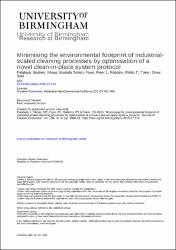| dc.contributor.author | Palabıyık, İbrahim | |
| dc.contributor.author | Yılmaz, Mustafa Tahsin | |
| dc.contributor.author | Fryer, Peter J. | |
| dc.contributor.author | Robbins, Phillip T. | |
| dc.contributor.author | Toker, Ömer Said | |
| dc.date.accessioned | 2022-05-11T14:44:53Z | |
| dc.date.available | 2022-05-11T14:44:53Z | |
| dc.date.issued | 2015 | |
| dc.identifier.issn | 0959-6526 | |
| dc.identifier.issn | 1879-1786 | |
| dc.identifier.uri | https://doi.org/10.1016/j.jclepro.2015.07.114 | |
| dc.identifier.uri | https://hdl.handle.net/20.500.11776/9817 | |
| dc.description.abstract | Cleaning of food fouling deposits in processing equipment is costly and time consuming. Fouling deposits form as a result of adhesion of species to the surface and cohesion between elements of the material. Cleaning can result from either or both adhesive and cohesive failure. In this study, the aim was to investigate the removal kinetics of an adhesive material and to design a novel cleaning in place (CIP) protocol for these kinds of materials at industrial scale to reduce environmental impact of cleaning processes. It was detected that different variables controlled the cleaning process in removal of adhesive deposit Temperature was not found as a significant variable in the initial stage of cleaning. Velocity of cleaning water controlled the cleaning at this stage when top layers of the deposit were removed by fluid mechanical removal due to breakdown of weak cohesive interaction. In the later cleaning stage, both velocity and temperature significantly contributed to cleaning, which suggested that both hydrodynamic forces and rheological changes are needed to overcome adhesion forces between the deposit and surface. Hence, a novel two step CIP protocol was proposed due to existence of different mechanisms in cleaning. When compared with conventional one step CIP protocols currently used in the processing plants, the proposed CIP protocol reduced the energy consumption by 40% without decreasing the cleaning efficiency. (C) 2015 Elsevier Ltd. All rights reserved. | en_US |
| dc.description.sponsorship | Turkish Ministry of National EducationMinistry of National Education - Turkey; ZEAL project [TP//ZEE/6/1/21191]; Technology Strategy Board's Collaborative Research and Development programme; BBSRCUK Research & Innovation (UKRI)Biotechnology and Biological Sciences Research Council (BBSRC) [BB/D523386/1] Funding Source: UKRI; EPSRCUK Research & Innovation (UKRI)Engineering & Physical Sciences Research Council (EPSRC) [EP/K011820/1] Funding Source: UKRI; Biotechnology and Biological Sciences Research CouncilUK Research & Innovation (UKRI)Biotechnology and Biological Sciences Research Council (BBSRC) [BB/D523386/1] Funding Source: researchfish; Engineering and Physical Sciences Research CouncilUK Research & Innovation (UKRI)Engineering & Physical Sciences Research Council (EPSRC) [EP/K011820/1] Funding Source: researchfish | en_US |
| dc.description.sponsorship | IP (the first author) acknowledges the financial support from the Turkish Ministry of National Education. This paper reports results from the ZEAL project TP//ZEE/6/1/21191, which involves; Alfa Laval, Cadbury Ltd., Ecolab Ltd., Newcastle University, Heineken UK Ltd., GEA Process Engineering Ltd., Unilever UK Central Resources Ltd., Imperial College of Science Technology and Medicine, GlaxSmithKline, Bruker Optics Ltd. and the University of Birmingham. The project is co-funded by the Technology Strategy Board's Collaborative Research and Development programme, following open competition. For more information visit < http://www.innovateuk.org >. | en_US |
| dc.language.iso | eng | en_US |
| dc.publisher | Elsevier Sci Ltd | en_US |
| dc.identifier.doi | 10.1016/j.jclepro.2015.07.114 | |
| dc.rights | info:eu-repo/semantics/openAccess | en_US |
| dc.subject | Cleaning in place | en_US |
| dc.subject | Optimisation | en_US |
| dc.subject | Adhesive material | en_US |
| dc.subject | Pilot scale experiments | en_US |
| dc.subject | Response surface methodology | en_US |
| dc.subject | Response-Surface Methodology | en_US |
| dc.subject | Deposits | en_US |
| dc.subject | Micromanipulation | en_US |
| dc.subject | Water | en_US |
| dc.subject | Whey | en_US |
| dc.title | Minimising the environmental footprint of industrial-scaled cleaning processes by optimisation of a novel clean-in-place system protocol | en_US |
| dc.type | article | en_US |
| dc.relation.ispartof | Journal of Cleaner Production | en_US |
| dc.department | Fakülteler, Ziraat Fakültesi, Gıda Mühendisliği Bölümü | en_US |
| dc.authorid | 0000-0003-4767-7839 | |
| dc.authorid | 0000-0002-5385-8858 | |
| dc.authorid | 0000-0002-7743-0872 | |
| dc.authorid | 0000-0002-7304-2071 | |
| dc.authorid | 0000-0001-8850-1819 | |
| dc.identifier.volume | 108 | en_US |
| dc.identifier.startpage | 1009 | en_US |
| dc.identifier.endpage | 1018 | en_US |
| dc.institutionauthor | Palabıyık, İbrahim | |
| dc.relation.publicationcategory | Makale - Uluslararası Hakemli Dergi - Kurum Öğretim Elemanı | en_US |
| dc.authorscopusid | 54411196400 | |
| dc.authorscopusid | 8396971300 | |
| dc.authorscopusid | 7005818645 | |
| dc.authorscopusid | 7201894295 | |
| dc.authorscopusid | 53878618900 | |
| dc.authorwosid | Fryer, Peter J/J-4778-2015 | |
| dc.authorwosid | Yilmaz, Mustafa Tahsin/O-3036-2015 | |
| dc.authorwosid | yu, wilson/AAC-8459-2021 | |
| dc.authorwosid | Toker, Omer Said/M-3991-2019 | |
| dc.authorwosid | palabiyik, ibrahim/V-3781-2017 | |
| dc.identifier.wos | WOS:000367762500092 | en_US |
| dc.identifier.scopus | 2-s2.0-84955722805 | en_US |



















